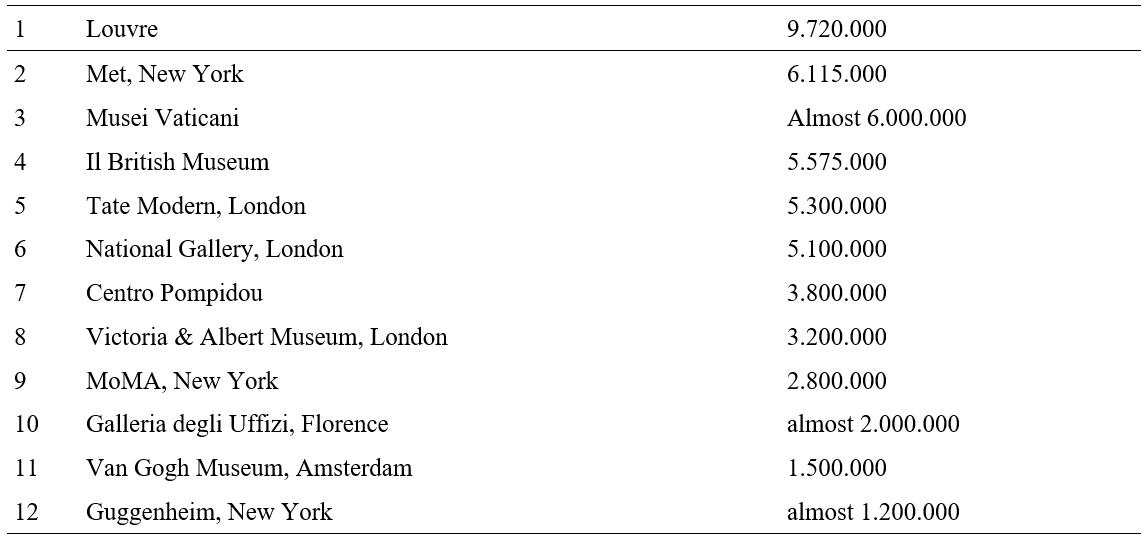Museums and Communication: The Case of the Louvre Museum at the Covid-19 Age
Abstract
In the last few decades, modern technology has changed the way people communicate. Owing to being an integral part of society, museums have also been influenced by this phenomenon. This paper aims to provide a general overview of the main communication tools, such as social media and the website. This work's purpose is to highlight how museums can reach a bi-directional communication that allows society to maintain a certain interaction with visitors, even in periods when physical access to the collections is not possible. In order to achieve this goal, the essay deals with the adoption of the main tools of modern communication by the Louvre Museum in Paris. It sets out the usage of Instagram, Facebook and the louvre.fr website and highlights the feedback before and after the lockdown occurred due to the Covid-19 virus.
References
Tsz Yin (Gigi) Au, Beth Chang, Michael Chee, Linda Cheu, Celia Datels, Lucia Fischer, Marina Hoffman, Olga Kondaurova, Kathleen LaClair, Jodie Lock, Jason Marshall, Sarah Linford, Jennie Nevin, Nina Patel, John Robinett, Judith Rubin, Matt Timmins, Chris YoshiiJudith Rubin, "Theme Index and Museums Index", TEA/AECOM, 2019
Binni Lanfranco and Giovanni Pinna, Museo. (1980). Storia e funzioni di una macchina culturale dal 500 a oggi, Garzanti, Milano.
Elisa Bonacini, (2016). Il Museo Salinas, paradosso del web marketing culturale, La comunicazione archeologica ai tempi dei social media, a museo chiuso. Archeomatica, 3, 12-17. https://doi.org/10.48258/arc.v7i3.1285
Verity Burke, Dolly Jørgensen & Finn Arne Jørgensen (2020). Museums at home: Digital Initiatives in Response to Covid-19. in Årgang 6, nr. 2-, s. 117-123.https://doi.org/10.18261/issn.2464-2525-2020-02-05
Lara Corona (2020). Museology and Communication within the virtual museum. Ulakbile, 44(1), 26-31, https://doi.org/10.7816/ulakbilge-08-44-03
Francesca De Gottardo, Alessandro D'Amore, Valeria Gasparotti, Aurora Raimondi Cominesi, (svegliamuseo) (2014). Comunicare la cultura online: una guida pratica per i musei-progettazione di siti web, content management, social media e analisi dei risultati, 2014.
Alberto Del Bimbo, (2020). Ricognizione Musei post Covid 19, in A. Del Bimbo et al., Museiemotivi e motivi post Covid 19, Musei Emotivi Board, New Media for Cultural Herirage.
Philip Effiom Ephraim (2019). Louvre Abu Dhabi: Social media in marketing culture. Proceedings of the 5th World Conference on Media and Mass Communication, 5(1), 49-57. https://doi.org/10.17501/24246778.2019.5105
Yves Evrard & Anne Krebs (2013). The authenticity of the museum experience in the digital age: The case of the Louvre. Journal of Cultural Economics, 37(3). https://doi.org/10.1007/s10824-017-9309-x
Fedora Filippi (2004). Manuale per la qualità dei siti web pubblici culturali, Ministero per i beni e le attività culturali- Progetto Minerva.
Ion Gil-Fuentetaja & Maria Economou (2019). Communicating Museum Collections Information Online: Analysis of the Philosophy of Communication extending the Constructivist approach. Journal on Computing and Cultural Heritage, 12(1), 3. https://doi.org/10.1145/3283253
De Gottardo, F., D'Amore, A., Gasparotti, V., & D’Eredità (2014). Comunicare la cultura on line: una guida pratica per i musei. Progettazione di siti web, content management, social media e analisi dei risultati, a cura di F. De Gottardi, A. D’Amore, V. Gasparotti, A. Raimondi Cominesi, 66-70.
Claudia Giraud (April 2020). Ermitage online: boom con undicimila visitatori il primo giorno in diretta dalle sale del museo, Artribune, 1.
Martina Griesser-Stermscheg (2013). Tabu depot: Das Museumsdepot in Geschichte und Gegenwart, Konservierungswissenschaft. Restaurierung. Technologie, Boehlau Verlag, Bohlau, 2013, ISBN 9783205788942.
Natalia Grincheva (2014). The Online museum: a placeless of the "Civic Laboratory". Anthropology Review, 8(1). https://doi.org/10.14434/mar.v8i1.3187
Linda Kelly (2013). Museum communication and social media, in Kirsten Drotner, Kim Christian Schrøder, The Connected museum in the world of social media, Routledge, New York.
Suzanne Keene (2014). Museums and the Digital: the view from the Micro Gallery, Conference: Electronic visualization and the Arts 2014. https://doi.org/10.14236/ewic/EVA2014.30
Neil Kotler, Philip Kotler & Wendy Kotler (2008). Museum Marketing and strategy, Wiley & Sons, 2008
Nicolette Mandarano (2019). “Musei e media digitali” Carocci, Milano, 2019, EAN 9788843095988
Andrew McClellan (1999). Inventing the Louvre, University of California Press, Berkeley, Los Angeles, London. ISBN 9780520221765.
Trilce Navarrete (Jun. 2018). On the Economics of Physical and Digital Collections in Museums. Uncommon Culture. 7, 1/2, 57-73.
Trilce Navarrete & Elena Villaespesa (2020). Digital Heritage Consumption: The case of the Metropolitan Museum of Art. Magazén, 1(2), 223-248, https://doi.org/10.30687/mag/2724-3923/2020/02/004
Network of European Museum Organisations. (2020). Survey on the impact of the COVID-19 situation on museums in Europe. Retrieved from https://www.ne- mo.org/fileadmin/Dateien/public/NEMO_documents/NEMO_COVID19_Report_12.05.2020.pdf
Gökçe Özdemir & Duygu Çelebi (2017). A social media framework of cultural museums. Advances in Hospitality and Tourism Research, 5(2), 101-119, https://doi.org/10.30519/ahtr.375248
Sabina Rosso, Romina Surace & Antonia Silvaggi (2016). "Museo del futuro”, Symbola, Roma, Isbn 9788894297614
Paolo Savona, Francesco Bellotti, Umberto Colombo, Gianpaolo Fabris, Vittorio Grilli, Salvatore Vicari “Rapporto innovazione e tecnologie digitali in Italia", Centro studi del Ministro per l'Innovazione e le Tecnologie, Roma, 2002, 87-89.
Ole Smordal & Dagny Stuedahl (2011). Designing for young visitorso co-composition of doubts in Cultural Historical Exhibitions. Computer Composition, 28(3), 215-223. https://doi.org/10.1016/j.compcom.2011.07.008
Monika Stobiecka (2019). Digital Escapism: How Objects Become Deprived of Matter. Journal of Contemporary Archeology, 5(2), 194-212. https://doi.org/10.1558/jca.34353
Villaespesa, Elena & Navarrete, Trilce (2019). Museum Collections on Wikipedia: Opening Up to Open Data Initiatives. MW19: MW 2019. Published on January 14, 2019. Consulted January, 4, 2021. Retrieved from https://mw19.mwconf.org/paper/museum-collections-on-wikipedia-opening-up-to-open-data-initiatives/
Alexandra Weilenmann, Thomas Hilman & Beata Jungselius, (2013). Instagram at the Museum: Communicating the Museum experience through social photo sharing, CHI13, proceedings of SIGCHI Conference on Human factors in computing systems. https://doi.org/10.1145/2470654.2466243
Michela Zingone (2019). Instagram as Digital Communication tool for the Museums: A reflection on Prospectives and Opportunities through the Analysis of the Profiles of Louvre Museum and Metropolitan Museum of New York. European Journal of Social Science, Education and Research, 6(3), 53-63, https://doi.org/10.26417/ejser.v6i3
Web sites
https://wearesocial.com/blog/2020/04/digital-around-the-world-in-april-2020
https://it.wikipedia.org/wiki/Lista_dei_musei_d%27arte_pi%C3%B9_visitati_al_mondo
http://www.minervaeurope.org/publications/qualitycriteria-i/indice0512/feliciatiwebculturale.html
https://www.britishmuseum.org/collection
https://www.moma.org/collection/
https://artsandculture.google.com/
https://www.macitynet.it/cultura-mobile-italy-by-art-nuova-app-mibact-per-ios/
https://www.scuderiequirinale.it/pagine/raffaello-oltre-la-mostra


This work is licensed under a Creative Commons Attribution 4.0 International License.
Copyright for this article is retained by the author(s), with first publication rights granted to the journal.
This is an open-access article distributed under the terms and conditions of the Creative Commons Attribution license (http://creativecommons.org/licenses/by/4.0/).









1.png)














